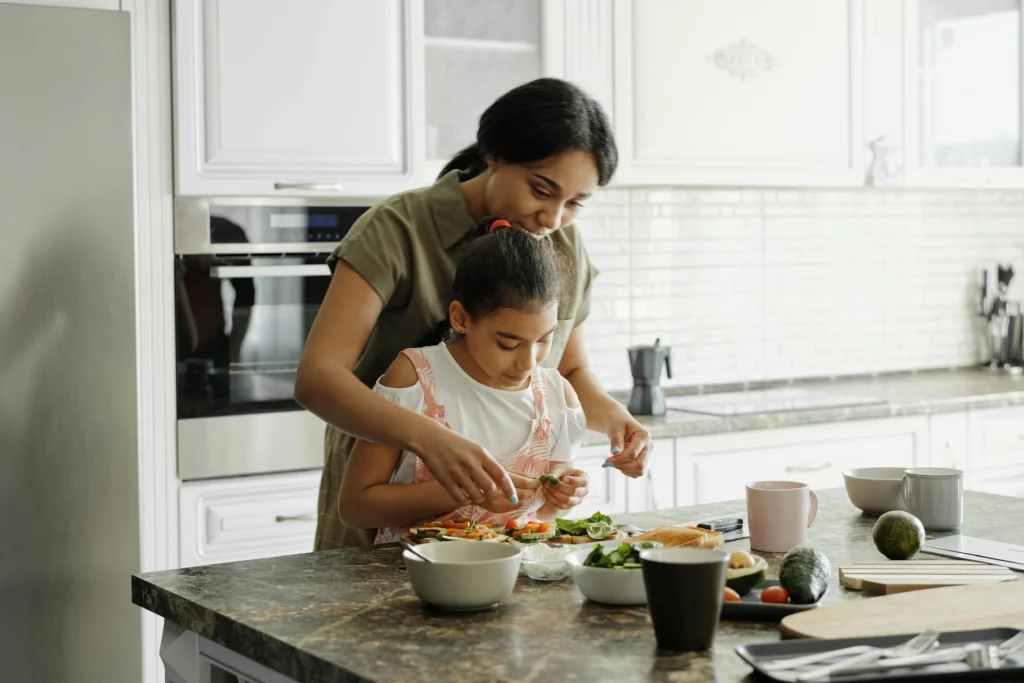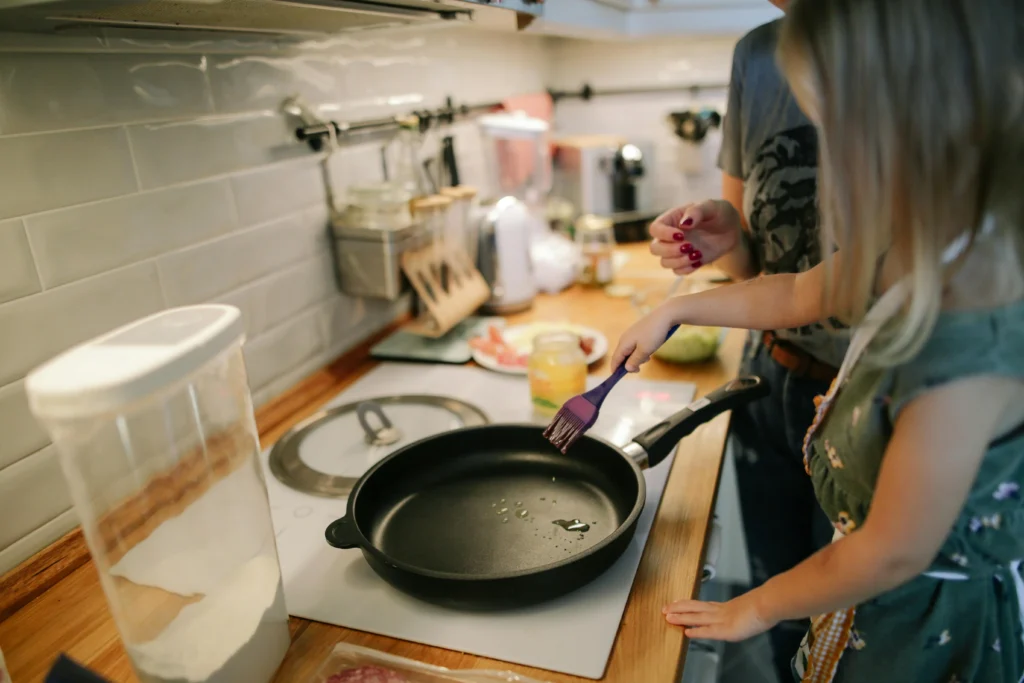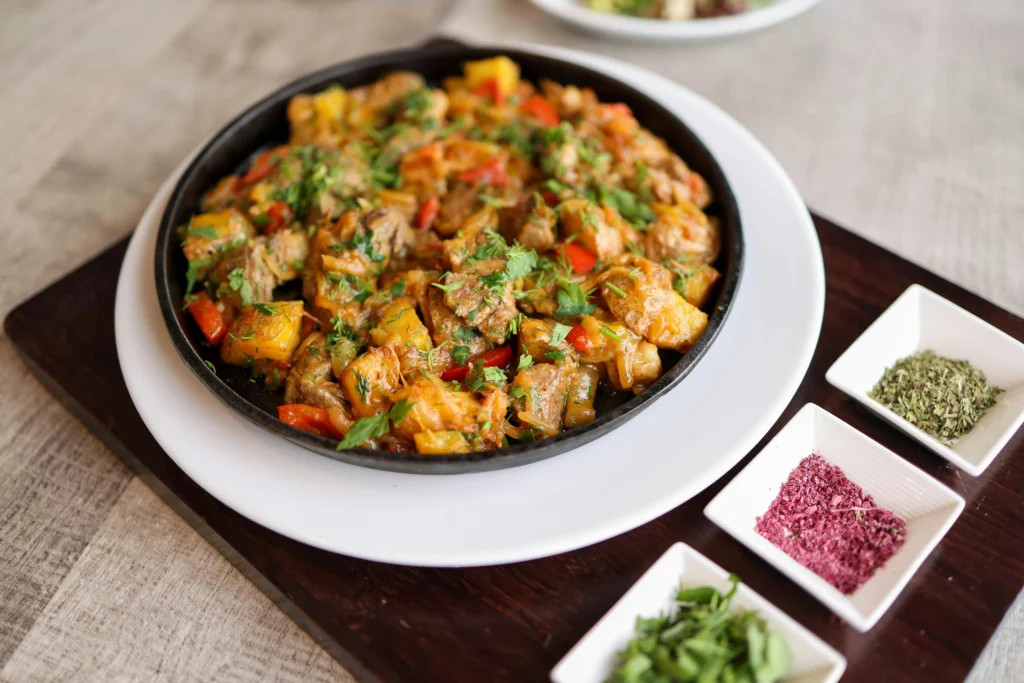Introduction
“Family Cooking 5 Epic Battles” Did you know that families who cook together have stronger bonds and experience increased joy and unity? It’s true! In this article, we will explore the incredible world of family cooking 5 epic battles, where preparing delicious meals becomes a fun and exciting team effort.
Cooking together as a family not only creates precious memories but also promotes healthy eating habits. By involving everyone in meal preparation, from parents to children, you can ensure that your family recipes are packed with nutritious ingredients. Get ready to embark on a culinary adventure that will bring joy, unity, and mouthwatering flavors to your dinner table!
Key Takeaways:
- Family cooking 5 epic battles can strengthen family bonds and enhance unity.
- Cooking together promotes healthy eating habits and nutritious family meals.
- Family recipes become a shared treasure, creating lasting memories for all.
- By involving children in the cooking process, you can develop their culinary skills and knowledge.
- Celebrate traditions and culture through family cooking, exploring diverse recipes and cooking activities.
Getting Started with Family Cooking
Getting the whole family involved in cooking can be a fun and rewarding experience. Not only does it provide an opportunity to bond and create lasting memories, but it also helps children develop essential life skills and encourages a love for healthy eating. If you’re ready to embark on this culinary adventure with your family, here are some tips and ideas to get you started.
1. Create a Welcoming Kitchen Environment

Make cooking an inviting and enjoyable experience by creating a welcoming kitchen environment. Clear your countertops, organize your tools and utensils, and ensure that everything is easily accessible. Consider playing some upbeat music or having a family playlist to set the mood.
2. Involve Children in Meal Planning
Engage your children in the meal planning process by letting them choose a recipe or ingredient for the upcoming meal. This not only empowers them but also helps develop their decision-making skills. Take turns allowing each family member to have a say in the menu.
3. Start with Simple Recipes
When it comes to cooking with children, it’s best to start with simple recipes that are easy to follow. Choose dishes that require minimal prep and cooking time, and are suitable for their age and skill level. This will help build their confidence and keep them engaged throughout the cooking process.
4. Assign Age-Appropriate Tasks
Assign age-appropriate tasks to each family member to ensure everyone has a role to play in the kitchen. Younger children can help with washing vegetables, stirring ingredients, or setting the table, while older children can assist with chopping, measuring, and following the recipe.
5. Make it Fun and Educational
Transform cooking into a fun and educational experience for the whole family. Incorporate learning opportunities by discussing nutrition, food origins, and different cooking techniques. Use this time to teach your children about healthy eating and the importance of a balanced diet.
6. Try New and Exciting Recipes
Keep the excitement alive by trying new and exciting recipes together as a family. Explore different cuisines, experiment with unique ingredients, and encourage everyone to step out of their comfort zones. This not only expands your culinary horizons but also exposes your children to a variety of flavors and textures.
Cooking with children can be a delightful experience that brings the family closer together. By following these tips and ideas, you can create a positive and memorable cooking journey for your entire family.
Family Recipes for All Ages

When it comes to family cooking, finding recipes that appeal to all ages can be a challenge. But fear not, we have curated a selection of delicious and nutritious family recipes that are sure to please everyone at the table. From comforting classics to creative twists, these meals are designed to bring joy and unity to your family kitchen.
At the heart of family cooking is the desire to provide healthy meals for our loved ones. By preparing meals together, we can instill good eating habits and teach our children the importance of nourishing their bodies. These recipes prioritize wholesome ingredients and balanced flavors, making them perfect for creating healthy family meals.
1. Veggie-packed Pasta Primavera
Loaded with vibrant vegetables and tossed in a light olive oil sauce, this pasta primavera recipe is a crowd-pleaser. The colorful medley of bell peppers, zucchini, carrots, and cherry tomatoes adds both nutrition and visual appeal to the dish. Serve it with whole wheat pasta for added fiber and nutrients.
2. Baked Chicken Nuggets
Swap store-bought chicken nuggets for this homemade version that is both healthier and tastier. These crispy baked chicken nuggets are made with lean chicken breast and coated in a crunchy whole wheat breadcrumb mixture. Serve them with a side of homemade sweet potato fries for a complete and kid-friendly meal.
3. Veggie Quesadillas
Quesadillas are a great way to sneak in extra veggies without sacrificing flavor. Fill whole wheat tortillas with a mixture of sautéed bell peppers, onions, and spinach, and sprinkle with a generous amount of melted cheese. Top with fresh salsa and guacamole for a burst of flavor that the whole family will love.
4. Turkey and Vegetable Meatballs
These turkey and vegetable meatballs are a healthier twist on a classic favorite. Packed with grated carrots and zucchini, they are moist, flavorful, and perfect for sneaking in extra vegetables. Serve them over whole wheat spaghetti or as a filling for sandwiches.
5. Berry Smoothie Bowl
Start your day with a burst of fruity goodness with this vibrant berry smoothie bowl. Blend together frozen mixed berries, banana, and Greek yogurt, then top with your favorite toppings such as granola, chia seeds, and fresh berries. It’s a nutritious and kid-friendly breakfast that will keep the whole family energized all morning.
| Recipe | Key Ingredients | Difficulty |
|---|---|---|
| Veggie-packed Pasta Primavera | Bell peppers, zucchini, carrots, cherry tomatoes | Easy |
| Baked Chicken Nuggets | Chicken breast, whole wheat breadcrumbs, sweet potatoes | Intermediate |
| Veggie Quesadillas | Bell peppers, onions, spinach, whole wheat tortillas | Easy |
| Turkey and Vegetable Meatballs | Ground turkey, carrots, zucchini, whole wheat spaghetti | Intermediate |
| Berry Smoothie Bowl | Mixed berries, banana, Greek yogurt | Easy |
These family recipes not only provide nutritious meals but also foster a love for cooking and bring the whole family together. Get creative in the kitchen, involve your kids, and make cooking an enjoyable experience for everyone. With these recipes, you can create healthy family meals that are both delicious and kid-friendly.
The Art of Meal Planning

Meal planning is a valuable tool for busy families who want to enjoy easy and delicious dinners on a regular basis. By taking the time to plan ahead, you can reduce stress, save time, and ensure that you have all the necessary ingredients on hand. Whether you’re a seasoned meal planner or just starting out, here are some tips and strategies to help you master the art of meal planning.
1. Plan Your Meals
Start by deciding on the meals you want to prepare for the week. Consider your family’s preferences, dietary restrictions, and any upcoming events or activities that may impact your schedule. Aim for a mix of family favorites and new recipes to keep things interesting.
2. Create a Shopping List
Once you have your meal plan, create a shopping list with all the ingredients you’ll need. Take inventory of your pantry and fridge to avoid buying items you already have. Organize your list by section to make shopping quicker and more efficient.
3. Prep Ahead
Spend some time prepping ingredients in advance to make cooking easier during the week. Wash and chop vegetables, marinate meats, and cook grains or beans. Store prepped ingredients in airtight containers in the fridge for easy access.
4. Embrace Leftovers
Leftovers are a meal planner’s best friend. Plan for larger portions that can be enjoyed as leftovers for lunch or repurposed into new dishes. Get creative with transforming last night’s dinner into a delicious lunch or dinner the next day.
5. Overcoming Cooking Challenges
Meal planning may come with its own set of challenges, but with the right strategies, you can overcome them. Here are some common cooking challenges and how to tackle them:
| Cooking Challenge | Solution |
|---|---|
| Lack of Time | Opt for quick and simple recipes or utilize time-saving appliances such as slow cookers or electric pressure cookers. |
| Picky Eaters | Involve your family in meal planning and let them choose a meal or a specific ingredient they enjoy. |
| Limited Ingredients | Be creative and experiment with substitutions or adapt recipes based on what you have available. |
| Budget Constraints | Plan meals around affordable ingredients and look for sales or discounts at the grocery store. |
By incorporating these strategies into your meal planning routine, you can overcome cooking challenges and enjoy easy family dinners that are both delicious and satisfying.
Family Cooking 5 Epic Battles: The Ultimate Competition

Family cooking is not just about preparing delicious meals together; it can also be a thrilling and friendly competition. Enter Family Cooking 5 Epic Battles, where family members take on cooking challenges to showcase their culinary skills and creativity. This ultimate competition adds excitement and a sense of achievement to the family cooking experience.
Creating challenges for the Family Cooking 5 Epic Battles is an opportunity to explore new recipes, cooking techniques, and flavors. Each battle can have a theme, such as a specific cuisine or ingredient, encouraging participants to think outside the box and experiment with different flavors and culinary traditions.
To organize a Family Cooking competition at home, start by deciding on the rules and guidelines. Will it be a timed challenge? Will there be a specific number of dishes to prepare? These decisions depend on the preferences and capabilities of your family members, ensuring that everyone can participate comfortably.
Once the cooking challenge is set, it’s time to divide into teams or compete individually. Each member can bring their unique strengths and cooking style to the table. Encourage creativity, collaboration, and healthy competition to enhance the overall experience.
Family Cooking 5 Epic Battles can include various rounds or categories, such as appetizers, main courses, desserts, or even presentation skills. This allows family members to showcase their expertise in different areas and adds an element of surprise to the competition.
Don’t forget to involve everyone, even the little ones! Children can take part by assisting or creating their own mini-recipes. This not only creates a fun and inclusive environment but also helps develop their culinary skills and confidence in the kitchen.
The ultimate goal of Family Cooking 5 Epic Battles is to have fun, bond as a family, and create memorable moments in the kitchen. Whether it’s celebrating the winning dish or enjoying a feast of all the creations, this competition brings joy, unity, and healthy competition to the table.
Building Skills in the Kitchen
Family cooking is not only a great way to bond and have fun, but it also offers numerous opportunities for children to learn and develop important skills in the kitchen. From basic cooking techniques to creativity and problem-solving, the kitchen becomes a wonderful classroom for kids to expand their knowledge and abilities.
Here are some fun family cooking ideas that can help children build their culinary skills:
- Measuring and Counting: Involve children in measuring and counting ingredients to improve their math skills. They can practice fractions, addition, and subtraction while following recipes.
- Knife Skills: Teach children how to safely handle knives and guide them in slicing, dicing, and chopping ingredients. Start with age-appropriate tasks, such as cutting soft fruits or using a plastic knife for spreading butter.
- Reading and Following Instructions: Encourage children to read recipes and follow instructions independently. This helps develop their reading comprehension and attention to detail.
- Creativity and Ingredient Substitutions: Let children experiment with ingredient substitutions and encourage them to get creative with flavors. This helps foster their imagination and problem-solving skills.
- Time Management: Teach children the importance of time management by assigning them specific tasks with deadlines. This helps them understand the importance of organization and working efficiently in the kitchen.
- Cleanup and Organization: Involve children in the cleanup process, teaching them the importance of keeping a tidy and organized kitchen. They can learn how to wash dishes, wipe counters, and put away ingredients and utensils.
By engaging children in these fun family cooking activities, they not only learn valuable culinary skills but also gain confidence and independence in the kitchen. Cooking with children creates a positive and nurturing environment where they can explore their creativity, develop healthy eating habits, and build a lifelong love for cooking.
Celebrating Traditions and Culture

Family cooking is not only about preparing delicious meals but also about celebrating traditions and culture. It provides an opportunity to pass down family recipes from one generation to another, preserving the flavors and memories that define our heritage. Cooking with children is a wonderful way to involve them in the cultural aspects of food and instill a sense of pride in their roots.
Here are some fun family cooking ideas that reflect different cultural backgrounds:
- Mexican Tacos: Get the whole family involved in making authentic Mexican tacos. From preparing the filling to assembling the toppings, everyone can contribute to this festive and flavorful meal. Discuss the cultural significance of tacos in Mexican cuisine.
- Italian Pasta: Teach your children how to make homemade pasta from scratch. Show them the traditional methods passed down through generations and explain the importance of pasta in Italian culture. Explore different pasta shapes and their regional origins.
- Indian Curry: Dive into the vibrant flavors of Indian cuisine by making a traditional curry together. Explore the vast array of spices used in Indian cooking and discuss the regional variations in recipes. Encourage children to experiment with different spice combinations.
Cooking and experimenting with recipes from diverse cultures not only broadens our culinary horizons but also fosters a deeper appreciation for the melting pot of flavors and traditions in our society. It allows us to connect with our heritage and understand the unique stories behind each dish.
Incorporating fun family cooking ideas that celebrate traditions and culture creates a memorable and educational experience for children. They learn about different cuisines, develop an understanding of cultural diversity, and build a strong connection to their own roots.
“Food is our common ground, a universal experience” – James Beard
Creating Lasting Memories
Family cooking 5 epic battles not only brings joy and unity but also creates lasting memories that will be cherished for years to come. Cooking together as a family provides a unique opportunity to bond, share experiences, and create traditions that will be passed down through generations.
When it comes to making cooking a memorable and enjoyable experience, there are a few key tips to keep in mind. First and foremost, involve everyone in the process. From young children to elderly grandparents, giving each family member a chance to contribute to the meal preparation fosters a sense of belonging and togetherness.
Try incorporating fun family cooking ideas into your kitchen routine. Get creative with themed cooking nights, where each family member takes turns choosing a cuisine or dish to prepare. This not only adds excitement to mealtime but also exposes the family to new flavors and cultures.
“Cooking together as a family provides a unique opportunity to bond, share experiences, and create traditions that will be passed down through generations.”
Another way to make family cooking a memorable experience is to create a special cooking space. Set aside a dedicated area in the kitchen where the family can gather and work together. From a designated cooking island to personalized aprons and utensils for each family member, these small touches can make a big difference in creating a fun and engaging atmosphere.
Making Memories in the Kitchen: Anecdotes from Real Families
Here are a few heartwarming stories from real families who have embraced the concept of family cooking battles and the joy it brings:
- Alice and her three children, Alex, Emma, and Liam, enjoy hosting their own family cooking competitions every Sunday. Each week, they choose a unique ingredient as the main focus and see who can come up with the most creative and delicious dish. These competitions not only stimulate their culinary creativity but also strengthen their bond as they cheer each other on.
- The Johnson family gathers in the kitchen every Friday night to prepare a homemade pizza feast. From kneading the dough to choosing the toppings, everyone gets involved. These pizza nights have become a tradition that the children look forward to every week, creating lasting memories of laughter, messiness, and delicious homemade pizza.
- Martha and her grandchildren, Lily and Noah, love exploring different cultures through their weekly family cooking adventures. From making sushi rolls to baking French pastries, they have discovered a shared passion for world cuisines. These cooking sessions not only teach them about different flavors but also open up conversations about geography and cultural diversity.
These anecdotes demonstrate the power of family cooking battles to create cherished memories and strengthen family bonds. Whether it’s through friendly competition, themed cooking nights, or exploring different cuisines, the experiences shared in the kitchen become an integral part of a family’s story.
Conclusion
In conclusion, Family Cooking 5 Epic Battles brings joy, unity, and healthy eating to families. By cooking together, families can create a strong bond while preparing delicious and nutritious meals. Throughout this article, we have explored the importance of family cooking, shared tips and recipes, and discussed the benefits it brings.
Family cooking not only allows children to develop valuable culinary skills but also teaches them the importance of healthy eating. Involving children in the cooking process instills a sense of ownership and adventure, making mealtime exciting and enjoyable for the whole family.
By organizing friendly culinary competitions and challenges, families can elevate their cooking experience and create unforgettable memories. Whether it’s trying out new recipes, celebrating cultural traditions, or simply enjoying quality time together, Family Cooking 5 Epic Battles offers endless opportunities for fun and learning.
So, why wait? Start your own Family Cooking 5 Epic Battles today and embark on a culinary journey that will nourish not only your bodies but also your souls. Discover the joy of cooking together, the unity it brings to your family, and the satisfaction of sharing healthy, delicious meals around the table.
FAQs
What are Family Cooking 5 Epic Battles?
Family Cooking 5 Epic Battles is a concept that encourages families to come together and bond over preparing meals. It involves creating fun challenges and friendly competitions in the kitchen, where family members can showcase their culinary skills and creativity.
Why is family cooking important?
Family cooking is important as it promotes unity and joy within the family. It provides an opportunity for family members to connect, work together, and create lasting memories. Additionally, cooking together allows for healthier eating habits, as you have control over the ingredients used in your meals.
How can I involve children in family cooking?
Involving children in family cooking can be a fun and educational experience. Start by assigning age-appropriate tasks such as stirring, measuring ingredients, or mixing. Encourage their creativity and allow them to contribute their ideas and preferences. It’s also a great opportunity to teach them about nutrition and food preparation techniques.
What are some kid-friendly cooking ideas?
Kid-friendly cooking ideas include making homemade pizzas, preparing fruit salad skewers, creating personalized wraps or sandwiches, and crafting colorful and nutritious smoothies. These activities not only encourage children to eat healthier but also allow them to explore different flavors and textures.
How can I plan easy family dinners?
To plan easy family dinners, start by creating a meal schedule for the week, taking into account everyone’s preferences and dietary requirements. Look for recipes that are quick to prepare and require minimal ingredients. Consider batch cooking to save time and energy. Get the family involved in the meal planning process and ensure there’s variety in the meals.
How can I organize a family cooking competition at home?
Organizing a family cooking competition at home can be a thrilling experience. Create challenges such as a mystery box challenge, where family members have to use specified ingredients, or a theme-based competition, where each participant prepares a dish from a particular cuisine. Assign a judge or have each family member vote for their favorite dish to determine the winner.
What skills can children develop through family cooking?
Family cooking helps children develop various skills such as creativity, teamwork, confidence, and basic cooking techniques. They learn about measurements, following recipes, and experimenting with flavors. They also enhance their fine motor skills while chopping, stirring, and decorating dishes.
How can family cooking celebrate traditions and culture?
Family cooking provides an opportunity to celebrate traditions and culture through preparing traditional recipes passed down through generations. Involve children in researching and preparing dishes that reflect their cultural background. This fosters a sense of pride in their heritage and deepens their understanding of different cuisines.
How can family cooking create lasting memories?
Family cooking creates lasting memories by bringing loved ones together in the kitchen. It’s a time for laughter, sharing stories, and creating new traditions. By cooking and enjoying meals together, you’re forging connections and building a strong sense of togetherness that will be cherished for years to come.